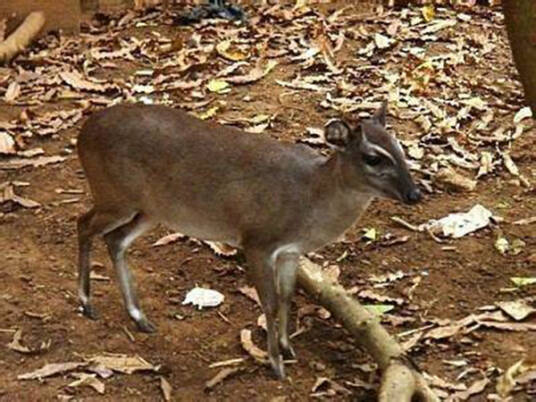Cephalophus spadix
IUCN
LCBasic Information
Scientific classification
- name:Cephalophus spadix
- Scientific Name:Tanzanite, Abbott's duiker
- Outline:Ungulata
- Family:Artiodactylus Bovidae Gazella
Vital signs
- length:100-140cm
- Weight:50-60kg
- lifetime:About 15 years
Feature
Relatively tall, with short legs, a thick neck, and a short, shiny coat that is generally dark brown or black.
Distribution and Habitat
The Tanzanian duiker is endemic to the African country of Tanzania, found in some montane and submontane forests in the north, east, and southwest. It is found in the forests of Mt Kilimanjaro, western Usambara, Rubeho and Udzungwa mountains, Mt Rungwe, and the southern highlands (Livingstone, Irungu, Irenga, Ndukunduku, Madehani). A 2013 survey confirmed the presence of the species in nine scattered forests in Udzungwa state.
It inhabits interiors and clearings of mature montane and submontane forests. On Mt Kilimanjaro, the duiker is reported to be most common between 1,300-2,700 meters. In the Udzungwa Mountains, the species has been recorded in the Matundu Forest, a large lowland and semi-deciduous forest, down to 300 m, and in the highest peak of Mount Luhombero, 2,600 m. It occurs in disturbed and secondary montane forests and bamboo forests to 2,500 m, and occasionally in highland grasslands to 2,800 m in Rungwe and Livingstone-Kitulo in the Southern Highlands.
Appearance
The Tanzanian duiker is 100-140 cm long, 65-75 cm tall at the shoulder, and 8-13 cm long tail; adults weigh 50-60 kg. It is a relatively tall duiker with short legs and a thick neck. The coat is short and shiny, and is dark brown or black overall. The underparts are light brown (often with a red tinge), and the throat and face are light gray-brown. The face has no distinct markings, but the upper lip is whitish and the forehead is dark brown. A thick head of long hair grows on the top of the head between the ears; the color varies from light brown to dark chestnut, but usually has a bright reddish color. Both sexes have spike-like horns that extend back from the top of the head in a straight line with the forehead. Although the horns are 8-12 cm long, compared to most other duikers, the horns are sometimes completely hidden by the thick forehead tuft.
Details
Tanzanian duiker (scientific name: Cephalophus spadix) English Abbott's Duiker, Minde, French Céphalophe d'Abbott, German Abbott-Ducker, Abbottducker, no subspecies. Tanzanian duiker and yellow-backed duiker are similar in size and color, but the yellow-backed duiker has a unique yellow wedge-shaped pattern from the middle back to the buttocks, and the forehead crown is shorter and sparser.

The Tanzanian duiker generally leads a solitary life. Due to its secretive nature, little is known about its behavior in the wild. Activity patterns derived from reports and camera traps suggest that the species is nocturnal and crepuscular, and like most duiker species, probably prefers dense understory vegetation, most likely spending the day in dense undergrowth. Hunters are well aware that this duiker uses regular paths (usually diagonally along hillsides) and often hunt this species with snares. If pursued, individuals may swim to escape the threat and may aggressively defend themselves if cornered. The Tanzanian duiker is rare throughout its range. Even in optimal habitat, the maximum population density is 1.3 individuals per square kilometer; in less suitable areas, the population density may be as low as 0.1 individuals per square kilometer.
Little is known about the reproduction of the Tanzanian duiker, although the species may be similar to the closely related yellow-backed duiker (Cephalophus silvicultor). Newborns have been observed in September and October, but the species may breed year-round.
The Tanzanian duiker is considered endangered. Although population data are sparse, the latest (2016) estimates suggest fewer than 1,500 mature individuals in four different regions, with continued declines, and scattered subpopulations (17-18 individuals total) in each region. This number is based on the maximum density estimated at the local prevalence site, and the total area of suitable habitat available at all sites, which has confirmed its presence. The Tanzanian duiker is locally extinct in several locations and is thought to have disappeared from other locations where it has been previously recorded. It is estimated that no subpopulation contains >250 mature individuals (the largest is about 200).
Listed in the IUCN Red List of Threatened Species in 2016 ver3.1 - Endangered (EN).
Protect wildlife and eliminate game.
Maintaining ecological balance is everyone's responsibility!








